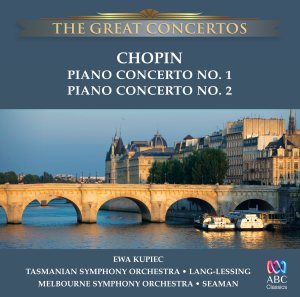 |
 |
|


alternatively
CD: MDT
|
Frédéric CHOPIN
(1810-1849)
Piano Concerto no. 2 in F minor, Op. 21 (1829) [33:57]
Piano Concerto no. 1 in E minor, Op. 11 (1829) [39:28]
 Ewa Kupiec (piano)
Ewa Kupiec (piano)
Tasmanian Symphony Orchestra/Sebastian Lang-Lessing (no. 2); Melbourne
Symphony Orchestra/Christopher Seaman (no. 1).
rec. 10-11 March 2011, Federation Concert Hall, Hobart (no. 2);
May 2005, Arts Centre, Hamer Hall, Melbourne (no. 1). DDD
 ABC CLASSICS 4764836 [73:25]
ABC CLASSICS 4764836 [73:25]
|
|
|
This new ABC disc of the Chopin concertos is a collaboration
between two Australian orchestras and the Polish pianist Ewa
Kupiec. The performances were recorded five years apart. The
Melbourne performance of No. 1 is taken from a live recording;
this performance is also available on another ABC Classics disc,
coupled with The Sorcerer’s Apprentice and the
Vaughan Williams Symphony no. 2. The Chopin piano concertos
are presented in reverse number order, with the F minor concerto
preceding its E minor companion. There are several possible
reasons for this. One is that, like the first two Beethoven
concertos, the second was written before the first. Another
is that it puts the superior performance and recording at the
beginning of the disc.
Although it is presumably a studio recording, the F minor concerto
is the more lively of the two readings. The orchestral introduction
to the first movement reveals the warm acoustic of the Federation
Concert Hall, Hobart, preserved nicely in this recording. The
Tasmanian Symphony Orchestra is among the smaller of the ABC
ensembles, but this allows the wind parts to register clearly;
the brass have a particularly good presence. The solo entry
is quite deliberate, rising to dramatic chords. The pulse is
flexible without being pulled around too much, indicating a
good understanding between Kupiec and Sebastian Lang-Lessing.
Kupiec has an attractive range of tone-colour, and the assured
way with Chopin that one associates with Polish pianists. She
handles the solo part with delicacy and strength; the lengthy
episodes of passage-work are played with clean articulation
and careful dynamic contouring. The Larghetto maintains this
quality, with a dreamy quality that recalls the Nocturnes. Kupiec
enters quietly at the beginning of the Allegro vivace, but builds
the tension in the contrasting episodes.
The E minor concerto was recorded six years earlier. Live recordings
generally have an extra electricity over those made in a studio,
but unfortunately that proves not to be the case here. The Melbourne
Symphony Orchestra is a bigger band than its Tasmanian counterpart,
and sounds more upholstered as it works its way through the
introduction to the Allegro maestoso. Unfortunately the woolly
acoustic of the Hamer Hall circa 2005 rather drains the life
out of things. Kupiec was also in more tentative form; her approach
to the solo has an air of caution lacking in the F minor concerto.
Things pick up somewhat in the Larghetto, with attractive crystalline
tone from the soloist; the arpeggiated “music box”
passage has an icy beauty. Things finally take off in the Vivace,
the opening of which prances around like a frisky colt. Although
it finishes strongly, overall this lacks the assurance of its
companion.
Artur Rubinstein’s stereo recordings of these concertos
date from the late fifties to early sixties; this puts the pianist’s
age at seventy-five for the later recording. There was not much
that he did not know by then about playing Chopin, and his performances
are natural and unaffected. Rubinstein’s timings are actually
a bit quicker than those by Kupiec, particularly in the first
movement of the F minor concerto (13:15 as against 15:00). The
age of the recordings is given away more by the boxy sound of
the tuttis than anything else.
Given the number of versions of these concertos available, this
one is too inconsistent to be a front-runner. The F minor is
very good, the E minor rather patchy. The orchestral contribution
is of a high standard in both. The recording of the F minor
at least has archival significance, in that it preserves the
acoustic of Hamer Hall before its recent redevelopment. Having
heard a concert there a few months ago, I can report that the
sound is much improved, and recordings made there from now on
will sound a lot brighter. Listeners who just want a good Chopin
concerto set are advised to investigate one of the numerous
alternative versions such as those from Rubinstein, Emanuel
Ax, Rafal Blechacz, Yevgeny Kissin or Maurizio Pollini.
Guy Aron
|
|

